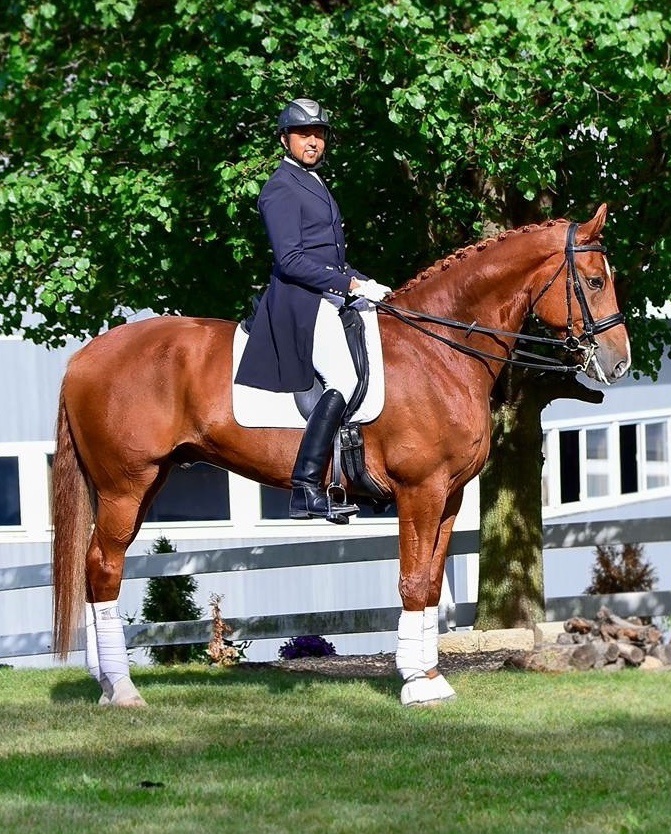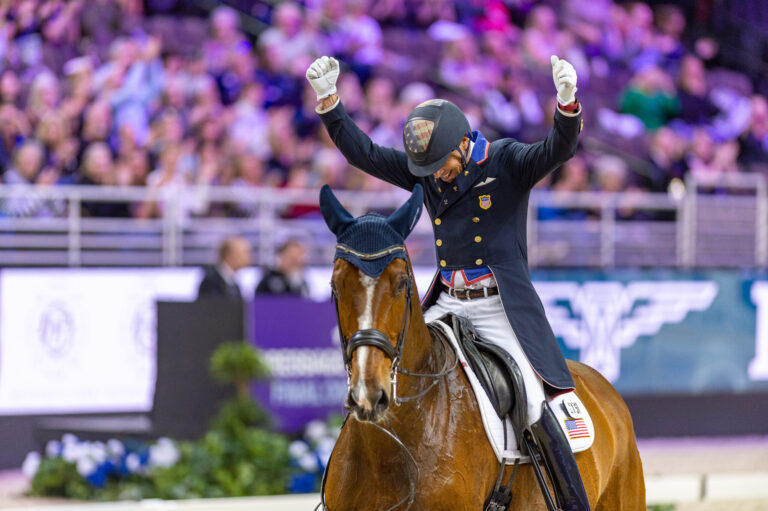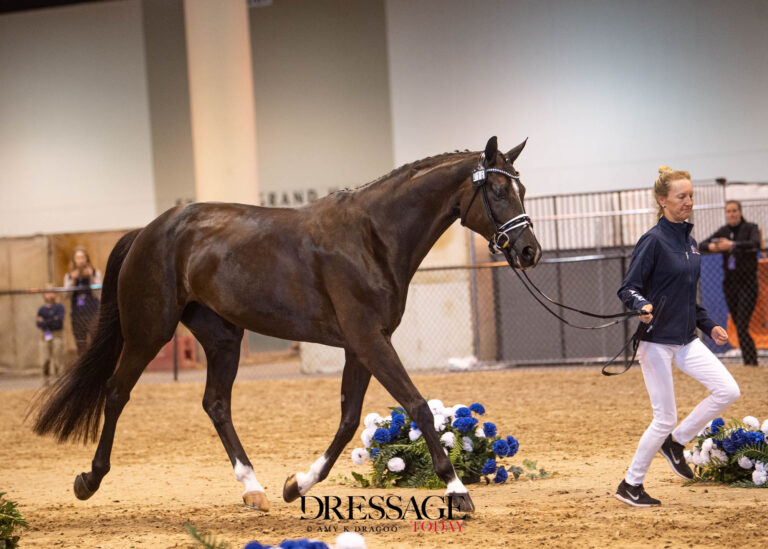Every time you ride down centerline at a show, there is a scribe sitting next to the judge, writing his or her comments and scores on your test. Most of us take for granted the fact that these volunteers spend the entire day hunched over, furiously scribbling down notes and scores. But in order to give each rider their full attention, every single judge must have a scribe.
Why do people subject themselves to hours sitting in a tiny judge’s box, exposed to the elements, getting writer’s cramp? Perhaps they are a rider who wants to give back to the sport. Maybe they’ve considered becoming a judge and want to see how things work. Or maybe a former rider, dressage fan or family member just wants to find a way to get involved.

In any case, if you choose to volunteer as a dressage scribe, you will get a front-row seat to a judge’s expert commentary.
(To read more about why you should consider volunteering at a dressage show, click here!)
Learning the Ropes
Last year, USEF licensed “r” dressage judge Jacquelyn Stapel offered a clinic at Four Farthing Farm in Lafayette, New Jersey, to help potential scribes learn the ropes. She printed up a mock show schedule and provided paper copies of dressage tests from Intro through Fourth Level, then played the “On the Levels” DVD (available for purchase here), featuring riders performing the tests, with commentary from judges including Anne Gribbons, Lilo Fore and Gary Rockwell.

Participants were seated at tables facing the screen, with tests in front of them, pens ready. Stapel played the video first with the volume off while she “judged” the tests herself, and participants wrote down her comments and scores; then she played the videos with the sound on so that participants could get a feel for different judges’ style. Tests ranged from Introductory Level to Fourth Level, and the difficulty of scribing increased with the difficulty of the tests.

This is something that anyone can practice at home: Just copy or print a few dressage tests and try to keep up with the judge’s commentary as you write down comments and scores. It’s trickier than you might think: While some judges speak slowly and keep comments short and concise, others give thorough descriptions of each movement or have an accent that you may have trouble understanding. Scribes must pick and choose while attempting to capture the essence of the comments. As the tests get more difficult and the movements start to come fast and furious, it takes concentration to stay sharp and focused on which movement the judge is describing.
Before you scribe, it would be helpful to familiarize yourself with the USDF Guide for Scribes. Also, when you decide to jump in and scribe, keep in mind that it’s easiest to start out with the lower levels. Find a schooling dressage show to give scribing a try, and give yourself a chance to learn the ropes when the stakes are not too high. You don’t want to be the scribe who writes the wrong scores down on a lifetime-best Grand Prix performance!
Be Prepared
Dressage shows and horse trials (which include a dressage test) are planned to the minute. Try to arrive at least 15 minutes early so that you can meet the judge, take a bathroom break and get situated before the start of the competition. “Being even five minutes late to a dressage show is a very big deal,” said Stapel. “Five minutes is a lightyear in dressage show time.”
Once you’re sitting in the judge’s box, make sure that you have everything you need: several pens, including a red pen for marking errors; updated day sheets including scratches/additions/changes to the schedule; the correct packet of tests for your judge (which you should check against the order of go); a bell or whistle and a watch set to the official show time; a stopwatch; a rock or other heavy object to use as a paper weight in case of windy weather.
Your dress should be neat, clean and comfortable. You will spend much of the day sitting, and while sometimes judges sit in a cushy vehicle provided by a sponsor, more often judge’s boxes are rudimentary structures that are open to the elements, and you’ll probably be sitting on a metal folding chair. Dress appropriately for the weather: If it’s cold, wear gloves, pack a blanket and throw a couple of hot packs in your pocket to warm up your hands as needed, since it’s difficult to write with frozen fingers. For sunny days, it’s perfectly acceptable to wear shorts and a T-shirt, but be sure to pack sunblock, sunglasses and a (not-too-floppy!) hat in case the sun shines directly onto you.
If it’s raining, wear a waterproof jacket with a hood or a rain hat, and when you open the door to the judge’s box, do so slowly and with some caution in case a spooky horse is present. Do not be the person who bangs open the door of the judge’s box wearing a flapping rain poncho and pops open an umbrella, spooking a horse and causing an accident.
Pack your own water to drink, and a few snacks if you tend to get hungry, but lunch should be provided by the show organizers. While it is important to stay hydrated, and a hot drink can help warm you up on a cold day, take it easy on the liquids. You cannot take a bathroom break until there is a break in the show schedule. That said, Stapel said if it’s a five-minute break, and it takes two minutes to walk to the port-a-potty, don’t be afraid to speak up and ask to jump to the front of the line so that you can get back to the judge promptly.
You Are There to Serve
A good scribe is often seen but not heard, as you do not want to distract the judge. Stapel advised that when you scribe, keep any gossip about horses and riders to yourself. The judge should be starting the competition with a clean slate. Resist the temptation to tell him or her all about how the horse entering the arena has bucked off every trainer in town or how the fancy warmblood just leaving warm-up arena cost more than your mortgage. Let him or her form their own opinions about the horse and rider in front of them.
“Judges don’t mind if you’re friendly, but if you have any personal information about the horse coming into the ring, keep it to yourself,” she said.
She also said that if you have any general questions for the judge, save them for the lunch break. They owe it to the competitor in the ring to give them their full attention, without distractions.
As a scribe, you will have a lot of paperwork to keep track of. Make sure that the test you are using matches the day sheet and, more importantly, the bridle number of the horse that is about to enter the arena. If there is any uncertainty about the rider’s identity, ask them to confirm their number/name before they begin their test. Riders scratch and schedules change, so it’s important that you stay on top of this throughout the day.
The Art of Scribing
One of your main goals as a scribe is to make sure that every rider who enters the arena gets an accurate account of the judge’s opinion. The competitor is relying on your notes to communicate the judge’s thoughts, so you want to write down as much as you can, as clearly as you can.
While there is no official dressage scribing shorthand, you can find out common abbreviations for dressage terminology, and use them. Stapel wrote down a few examples: “EXT” for extension, “STR” for straight and so on. Stapel suggested leaving out vowels or using shorter words.
You’ll be taking a lot of notes throughout the day, so get creative: draw a picture of an O for “circle” or draw a square to describe a square halt. The USDF Guide for Scribes also includes a handy list of suggested abbreviations that you should familiarize yourself with beforehand.
Note that in a musical freestyle, the scribe is only responsible for writing down comments on the Technical side of the test; the judge will write their own comments on the Creative side.
Your job is to write the judge’s comments and the scores. If you do not hear the judge, or if you miss a score, ask right away. It’s very difficult to go back and figure out what score should be assigned to a particular movement, so it’s better to briefly interrupt by asking the judge to repeat herself right then and there. If you get behind and have to choose between writing down a comment and writing down a score, always record the score. You can leave the comment section blank for a movement or two if you need to catch up.
Stapel said that when she is judging, she sometimes makes a short comment like, “Now we’re on the free walk,” which is a slow movement and gives the judge and scribe a moment to catch up or breathe, and to make sure that they are still in sync.
In any test, be sure to write down full points and half points. Rather than writing “7,” write “7.0” for full points or “7.5” for half points. You do not need to write down coefficients, and you do not need to calculate final scores. The scorer, who is probably back at the secretary’s office, will handle that.
Sometimes riders perform the wrong movement or go completely off course in their test. You will need to record an error, and you should have a red pen for marking the test. Just write “ERROR” next to the movement so the scorer can find this later, and circle the word to get the scorer’s attention. You can write -2 for each error, but leave the totaling of the errors for the scorer.
An Important Role
Volunteering as a scribe is an important role in the sport of dressage. The show quite literally cannot go on without someone to write down the judge’s scores and comments. If you have been considering offering your services as a scribe, take Stapel’s advice and go for it.
“I talk to so many people who want to scribe, and they’re intimidated,” she said. “They are concerned about not doing a good job or getting lost, et cetera. If you’re a rider, you’ve received tests before and you know what the comments look like. There are no rules; if you can get the point across and the competitor can figure out at the end of the day what the judge was saying, you’ve done a good job.”











